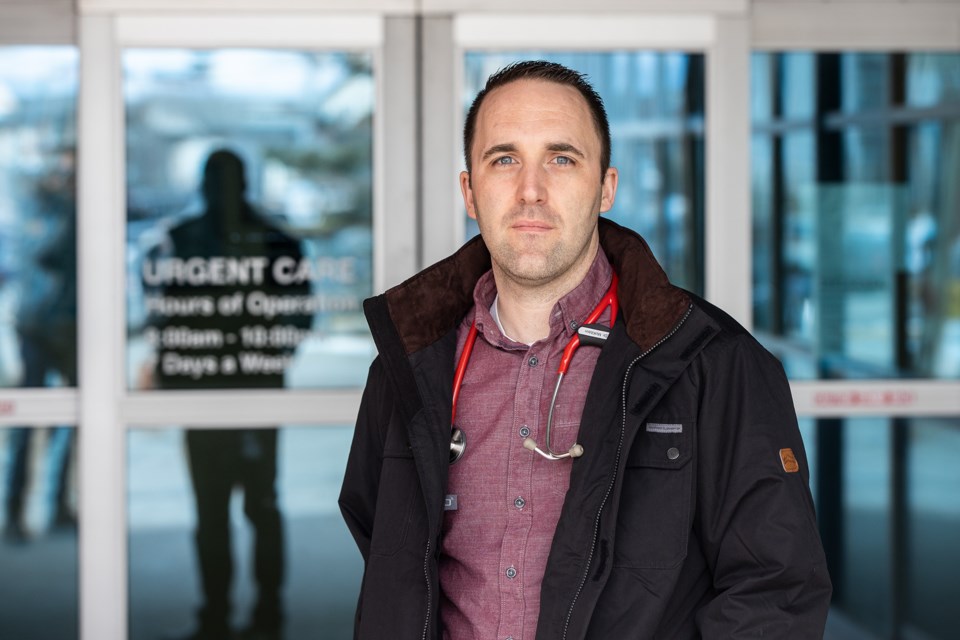Doctor appointments have taken a new twist to protect physicians and their patients from potential COVID-19 exposure.
During the last week of March the Alberta College of Physicians and Surgeons directed that people not be seen in-person unless absolutely necessary.
Dr. Troy McKibbin said at the Westmount Pinnacle Medical Clinic, where he practises as a family doctor, it means 95 per cent of visits are now over the telephone.
“It’s interesting,” said McKibbin. “It’s challenging for us to do assessments over the phone, but we’re doing the best we can.”
He said there are still some issues that warrant a physical examination, such as children who have had sustained fevers and may have ear infections or people whose stories raise alarms – like sudden onset abdominal pain, which could be appendicitis.
“If there’s back pain with some specific features that we call red flags, then we would need to see them in-person and we may need to get some imaging,” said McKibbin.
Urgent imaging services may be done, but he said many patients who have been waiting for MRI scans for longstanding issues will have to wait longer, as those diagnostic services have been delayed.
Many of the issues family doctors see patients for involve prescription refills or monitoring blood pressure or other ongoing concerns, which McKibbin said can be handled remotely for the most part – as long as people are forthcoming in their responses to questions and happen to have equipment like a blood pressure cuff at their disposal.
Essentially, family doctors are triaging by telephone, handling concerns when they can or, if something is particularly worrisome, arranging a time for people to be seen in the clinic. Because there are virtually no patients coming in, he said it’s easier to ensure people visiting in-person are not exposed to COVID-19.
Urgent care is still operational for emergencies, like wounds requiring stitches or broken bones, but he said those with more minor issues are encouraged not to visit a doctor.
“If you can self-isolate at home with minor symptoms and you’re not putting yourself or others at risk by doing that, then stay home,” said McKibbin. “It’s the same consistent messaging with Dr. (Deena) Hinshaw (chief medical officer of Alberta), basically.”
While telephone consultations are posing some challenges, he said the College of Physicians and Surgeons recently announced it would provide avenues for family doctors to use videoconferencing as a means of meeting with patients – something that is not traditionally permitted because of concerns over confidentiality on unsecured services.
“The college says because of the extraordinary nature of this and because patients may not have access to a specific type of videoconferencing options that we’re able to use various options for that,” said McKibbin. “We have to tell people they’re not secure, there’s potential their information could be seen by somebody else.”
Overall, the number of visits – even remote ones – has dropped drastically over the past two weeks, he said. He said it’s proof people are doing a good job of staying at home and social distancing, but it also poses a financial concern for medical offices in town.
Westmount Pinnacle has seen about a 70 per cent drop in the number of patients seen daily, and the clinic has been forced to lay off all but one member of its non-physician staff.
The government has recognized the shift to telephone consultations, and gave doctors a code to bill $20 per call, but McKibbin said it doesn’t necessarily align with regular payment structures for family physicians.
Time modifiers for in-person visits allow doctors to be paid $18 more if patients are seen for 15 minutes or longer. However, with the telephone consults the time modifier kicks in at 10 minutes – but a half-hour long call will be paid the same amount as a 10-minute one, he said.
“It’s financially challenging, and I’m hopeful all the clinics will make it through,” said McKibbin.
He said the main message doctors want their patients to take away is that they are still available to see them, though it may be virtual for the time being. Regular appointments can be made, though they will be done in a fairly irregular way, he said.
“It’s definitely an interesting experience,” said McKibbin. “Very different from our normal way of doing things, and we’ll all be happy when we get back to actually being able to examine patients more routinely, but we’re doing everything we can to avoid that for now.”
Krista Conrad, OkotoksToday.ca
COVID-19 UPDATE: Follow our COVID-19 special section for the latest local and national news on the coronavirus pandemic, as well as resources, FAQs and more.




